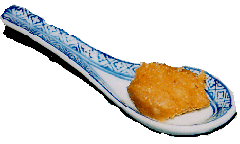 © Copyright Laurence Saettel |
It is a rich and salty condiment used in Asian cuisine. Process Miso varies widely in flavor, color, texture and aroma depending on its content of soybeans, the amount of salt and the fermentation time. |
 © Copyright Laurence Saettel |
It is a rich and salty condiment used in Asian cuisine. Process Miso varies widely in flavor, color, texture and aroma depending on its content of soybeans, the amount of salt and the fermentation time. |
Storage
It must be stored in the refrigerator and can be kept for several months.
Nutritional values
Unpasteurized miso provides vitamins and minerals and is also a source of lactobacillus. It is a bacterium which aids digestion and the proper absorption of nutrients.
|
100 g of miso provide
|
|
| Calories |
284
|
| Proteins |
16 g
|
| Fats |
8 g
|
| Carbohydrates |
36 g
|
| Calcium |
92 mg
|
| Iron |
4 mg
|
| Zinc |
5 mg
|
Japanese people start the day with a miso soup.
How to use it?It is high in sodium and thus must be used sparingly.
Recipe
Miso soup
Realized by Laurence LIVERNAIS-SAETTEL, dietetian
© Copyright L. Livernais-Saettel 2002
Site hosted by MaVille-Online.